


xxxxxAs we have seen, it was in 1800 (G3b) that the Italian physicist Alessandro Volta produced the first battery. It was by using this source of current electricity that in 1820 the Danish physicist and chemist Hans Christian Oersted discovered by chance that an electric current in a wire was able to deflect a magnetic needle. This had far reaching consequences in the field of electromagnetism. In addition to this research, Oersted also worked on the compressibility of gases and liquids, and in 1825 was the first to isolate aluminum. As we shall see, following Oersted’s discovery of 1820, the French physicist and mathematician André Marie Ampère elaborated on his findings, and in 1831 (W4), benefiting from this additional research, the English scientist Michael Faraday made the first dynamo, and laid the foundation for the development of a workable electric motor and generator.
HANS CHRISTIAN OERSTED 1777 -
(G3a, G3b, G3c, G4, W4, Va)
Acknowledgements
Oersted: statue by the Danish sculptor J.A. Jerichau (1816-
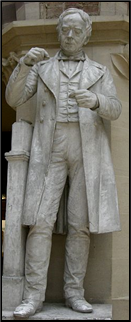 xxxxxIt was in April 1820, while giving a public demonstration, that the Danish physicist and chemist Hans Christian Oersted discovered by chance that electric current in a wire was able to deflect a magnetic needle, a discovery which was to have far reaching consequences in the field of electromagnetism within the space of a few years -
xxxxxIt was in April 1820, while giving a public demonstration, that the Danish physicist and chemist Hans Christian Oersted discovered by chance that electric current in a wire was able to deflect a magnetic needle, a discovery which was to have far reaching consequences in the field of electromagnetism within the space of a few years -
xxxxxOersted was born at Rudkobing, Langeland. After studying at the University of Copenhagen and receiving his doctorate in 1799, he worked as a pharmacist before going on a tour of Europe in the opening years of the new century. On his return in 1803, his public lectures and demonstrations proved highly successful, and led to his being appointed professor of physics at Copenhagen three years later. There he conducted research, mainly in electric currents and acoustics. He held this post until 1829, when he became director of the capital’s Polytechnic Institute. His major work, Manual of Mechanical Physics appeared in 1844. (The statue illustrated here is at the Museum of Natural History, Oxford University.)
xxxxxAs we have seen, as early as 1786 the Italian physiologist Luigi Galvani, dissecting a dead frog, had discovered the electrical nature of nervous impulse, and it was around this time, too, that the French physicist Charles Coulomb put forward a number of significant papers on electricity and magnetism. However, it was the Italian physicist Count Alessandro Volta who, in 1800 (G3b), turned his attention to current electricity and produced the first battery, known as the “voltaic pile”. This provided the first ready source of current electricity, and it was by using this sustained source that Oersted was able to make the first connection between magnetism and electricity.
xxxxxBy 1806 Oersted had become convinced that there was a direct rel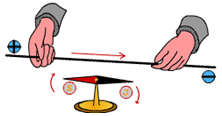 ationship between electricity and magnetism, and he predicted the same in 1813. However, it took a further seven years of experiments before, by placing a current in a wire parallel to the magnet needle instead of transverse to it, he stumbled on the means of proving that electric current flowing in a wire produced its own magnetic field.
ationship between electricity and magnetism, and he predicted the same in 1813. However, it took a further seven years of experiments before, by placing a current in a wire parallel to the magnet needle instead of transverse to it, he stumbled on the means of proving that electric current flowing in a wire produced its own magnetic field.
xxxxxIn addition to his pioneer work in electromagnetism, Oersted also worked on the compressibility of gases and liquids, and in 1825 he was the first to isolate aluminium, describing it as a metal which “in colour and lustre somewhat resembles tin”. This metal had been discovered by the English chemist Humphry Davy in 1808. He had named it aluminum (now generally known as “aluminium” save in the United States), but he had been unable to separate it from its oxide.

xxxxxAs we shall see, Oersted’s discovery of the phenomenon of electromagnetism brought quick results and benefits. Almost at once, the French physicist André Ampère, in collaboration with his countryman François Arago, elaborated on his findings. In 1827 the German mathematician Karl Gauss and the German physicist Wilhelm Weber invented the first practical electromagnetic telegraph; and, as we shall see, in 1831 (W4) the English scientist Michael Faraday made the first dynamo, and laid the foundation for the development of practical electric motors and generators.
xxxxxIncidentally, the phenomenon of electromagnetism was first discovered in 1802, in fact, by an Italian jurist named Gian Domenico Romagnosi (1761-
xxxxx…… In 1824 Oersted founded a society dedicated to the spread of scientific knowledge, and since 1908 this society has awarded the Oersted Medal to a Danish scientist who has made a significant contribution to science. ……
xxxxx…… The unit of magnetic-
Including:
André Marie Ampère
and Georg Simon Ohm

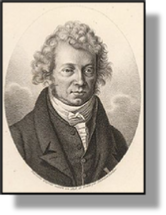 xxxxxOne of the most talented scientists to follow in the footsteps of Hans Oersted was the French physicist and mathematician André Marie Ampère (1775-
xxxxxOne of the most talented scientists to follow in the footsteps of Hans Oersted was the French physicist and mathematician André Marie Ampère (1775-
xxxxxAmpère was born near Lyon and showed an extraordinary talent in mathematics as a child. He survived the French Revolution, being 14 when it began, but his father, Lyon’s Justice of the Peace, was guillotined when the city fell to the revolutionaries. He was devastated by his father’s death, and did not return to his studies for eighteen months. He taught science locally until 1802, and then took up teaching posts, first at Bourg and then in Paris. In 1809 he was appointed professor of mathematics at the École Polytechnique and, beginning in 1824, taught physics at the Collège de France and philosophy at the Faculté des Lettres.
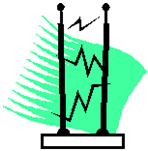 xxxxxIn a series of papers beginning in 1820 Ampère fully expounded the theory and basic laws of what he called electrodynamics (electromagnetism). Within a week of learning of Oersted’s discovery, he proved by experiment that two parallel wires carrying current in the same direction attracted each other, whilst currents travelling in opposite directions repelled each other. And from this finding he went on to demonstrate that the direction of the magnetic field is determined by the direction of the current.
xxxxxIn a series of papers beginning in 1820 Ampère fully expounded the theory and basic laws of what he called electrodynamics (electromagnetism). Within a week of learning of Oersted’s discovery, he proved by experiment that two parallel wires carrying current in the same direction attracted each other, whilst currents travelling in opposite directions repelled each other. And from this finding he went on to demonstrate that the direction of the magnetic field is determined by the direction of the current.
xxxxxAnd he further showed, in collaboration with his fellow countryman and physicist François Arago, that an electric current passing through a solenoid (a coil of wire carrying direct current) had the effect of increasing the permanent magnetism of an iron needle situated within that solenoid.
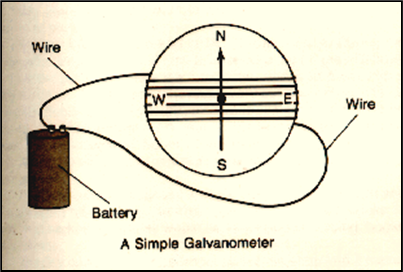 xxxxxToday, however, he is remembered above all for Ampère’s Law or Theorem, a mathematical equation which quantifies the relationship of the strength of a magnetic field to that of the electric current that produces it. And he was, too, the first person to devise a technique to measure electricity. He built an instrument which employed a free-
xxxxxToday, however, he is remembered above all for Ampère’s Law or Theorem, a mathematical equation which quantifies the relationship of the strength of a magnetic field to that of the electric current that produces it. And he was, too, the first person to devise a technique to measure electricity. He built an instrument which employed a free-
xxxxxHe wrote a book on the probability theory in 1802 (Considerations on the Mathematical Theory of Games), but his theories on electricity and magnetism were published in two later works, his Collection of Observations on Electrodynamics of 1822, and his Theory of Electrodynamic Phenomena four years later.
xxxxxIncidentally, the ampère (or amp), the unit for measuring electric current, was named after the French scientist. ……
xxxxx…… Ampère strongly supported the wave theory of light advanced by the French physicist Augustin-
xxxxx…… Amongstxother French scientists of the day who reacted quickly to Oersted’s discovery of 1820 were Jean-
xxxxxFollowing Hans Oersted’s discovery of 1820 concerning the relationship between electricity and magnetism, research in this field was ably continued by the French physicist and mathematician André Marie Ampère (1775-
G4-
xxxxxThe German physicist Georg Simon Ohm (1789-
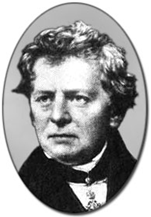 xxxxxAnother physicist who stamped his name on scientific data was the German Georg Simon Ohm (1789-
xxxxxAnother physicist who stamped his name on scientific data was the German Georg Simon Ohm (1789- rsely proportional to resistance. The ohm, the common unit of electrical resistance, is also named after him, and the unit of conductance is called the mho, (ohm spelled backwards), though in many cases the term siemens has taken its place.
rsely proportional to resistance. The ohm, the common unit of electrical resistance, is also named after him, and the unit of conductance is called the mho, (ohm spelled backwards), though in many cases the term siemens has taken its place.
xxxxxBorn and educated in Erlangen, Bavaria, he was appointed professor of mathematics at the Jesuits’ College at Cologne in 1817, but he felt that his research there -


